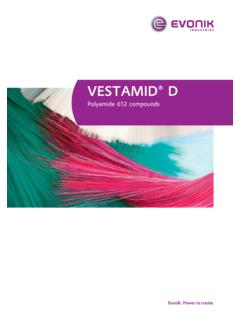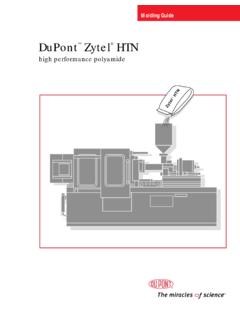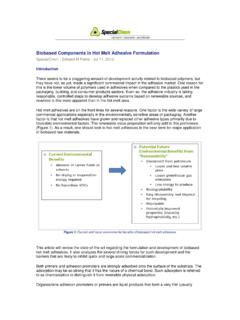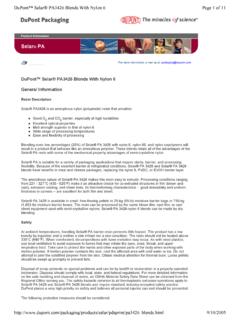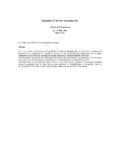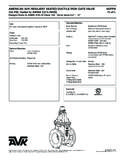Transcription of Technical Information - Processing of VESTAMID® L, D, E ...
1 Evonik Resource Efficiency GmbH | VESTAMID | September 2017 1/8 VESTAMID compounds are processed mainly in the form of granules. For Processing we recommend that you follow the Information in this flyer. Evonik offers extensive Technical service that is dedicated to finding technically sophisticated system solutions together with our customers. This includes support with simulation calculations for developing tools and molds. DRYING VESTAMID polyamide compounds are supplied as granules in 25 kg moisture-proof bags; octabins of 1,000 kg can also be provided on request. In our experience, the shelf life is virtually unlimited under normal storage conditions if the packaging is not damaged.
2 The storage temperature should not exceed 45 C, particularly for plasticized molding compounds. RECOMMENDED DRYING CONDITIONS FOR VESTAMID COMPOUNDS Prior to the opening of the bag, the contents should be allowed to reach the ambient temperature, in order to avoid moisture condensing on the cold granules. VESTAMID granules will slowly absorb moisture from the air and hence any bags that are opened but not completely used should be closed again as tight as possible. Feed hoppers of the Processing machines should not be filled excessively with more granules than the Processing limit within two hours and should be closed with a lid. Drying of the granules is necessary only if the packaging has been damaged or the pack has been open for more than two hours.
3 In such cases the compounds should be dried until the water content again falls below percent. Excessively high moisture content in the compound leads to Processing problems and/or poor molding properties. Technical Information Processing of VESTAMID L, D, E und Terra Type Drying Temperature [ C] Drying periode [h] dehumidified air drying oven circulated air drying oven fresh air drying oven PA 12 80 - 100 2 - 4 2 - 16 2 - 10 PA 12 plasticized 80 2- 4 2 - 12 2 8 PA 1010 PA 1010 plasticized 80 100 80 2 -4 4 2 - 16 2 - 12 2 - 10 2 - 8 PA 612 PA 612 plasticized* 80 100 80 2 -4 4 2 - 16 2 - 12 2 - 10 2 - 8 PA 610 PA 610 plasticized PA 1012 PA 1012 plasticized 80 110 80 80 100 80 2 -4 4 2 - 4 4 2 - 16 2 - 12 2 - 16 2 - 12 2 - 10 2 - 8 2 - 10 2 - 8 PEBA 80 2 - 4 2 - 10 2 - 6 * VESTAMID DX9325 Evonik Resource Efficiency GmbH | VESTAMID | September 2017 2/8 INCOMPATIBILITY WITH OTHER THERMOPLASTICS VESTAMID is not compatible with the other
4 Polyamides, and is least to mention about other plastics too. It shall be noted that even VESTAMID resins based on PA 12 and PA 612 are not compatible with each other. However PA 12 and PA 12 elastomers will posses limited compatibility with each other. Molded parts of VESTAMID which contain traces of foreign polymers will normally embody inferior properties compared with uncontaminated polyamide. The weld lines of the melt behind mandrel carriers in the extrusion or behind cores in injection molding will especially initiate a substantially reduced strength in case of contamination with foreign polymers. Thus, it is extremely important to clean the machine thoroughly before start up of the production.
5 COLORING OF VESTAMID VESTAMID compounds are supplied in a range of standard colors. Special colors are available for orders of viable commercial quantities. VESTAMID compounds are pigmentable during Processing . The preferred method is by using a color concentrate based on PA 12 for PA 12 or PEBA compounds and PA 612 for PA 612 compounds. The same is valid for PA 610, PA 1010, and PA 1012 compounds. Dry coloring by tumbling with finely powdered colorants is another possibility but is nonetheless inconvenient. Pneumatic conveyance is then ruled out. The use of color pastes or color concentration having a "neutral" ( PE) base can lead to incompatibility with PA 12 and hence creating poor parts properties (inferior weld line strength or cold impact resistance).
6 Therefore, preliminary testing of compatibility is absolutely important. Processing OF VESTAMID COMPOUNDS Generally, the working areas of all thermoplastics Processing should be well ventilated especially during the production. It is recommended that an exhaust system should be located over the machine nozzles. This is particularly true for resins containing plasticizers or flame retardant additives. Under the circumstances of unfavorable conditions, for example given in the Processing of excessively elevated temperatures, or during cleaning of the screws by burning off remaining polymer residues, it is possible that small amounts of noxious fumes would be produced.
7 Therefore, the cleaning of screws by burning off should always be done under an exhaust hood. Further details are notable from the relevant safety data sheet. INJECTION MOLDING Plasticizing unit Screw and cylinder: Three zone screw with a length between 18 and 22 D Depth flight ratio shall be > 2 Minimum flight depth: 2 mm in the metering zone, and 4 mm in the feeding zone Screw and barrel diameter should be in the magnitude that a metering stroke between 1 D and 3 D is realizable For more Information see Figure Three-zone-screw on page 3. Peripheral Screw Speed: In the range of 3 - 12 m/min optimal Larger speeds ( > 18 m/min) can be applied, but might lead to problems in Processing .
8 Nozzle: In general free-flow nozzles, for low viscous resins ( , VESTAMID L1670, VESTAMID L1723) externally operated shut-off nozzles ( needle valve nozzle) are recommended Bore of nozzle should be app. to mm smaller than the gate Back flow valve: Clearance between back flow valve and cylinder shall be mm Cleaning: Light contamination ( cleaning due to changing of resin) 1) Prepare the mixture of high viscous PP and purging resin PLEXIFIX with a mixing ratio of 2:1. 2) Increase the temperature settings of heating zones by 30 to 40 K but not above 300 C. 3) Plasticise the mixture with a long metering stroke and high dynamic pressure and discharge with high speed into the atmospheric environment.
9 4) Flush the plasticating unit with the new resin until no purging mixture is contained in the melt . Evonik Resource Efficiency GmbH | VESTAMID | September 2017 3/8 Persistent contamination Persistent contamination can be mostly removed only by mechanical cleaning of screw, cylinder, back-flow valve etc. Sometimes a cleaning of the cylinder can be avoided by using special purging material such as RAPID PURGE, SUPERNOVA or ASACLEAN. Clamping Unit Clamping force: Guide number for maximal pressure in cavity with VESTAMID resins: 200 to 600 bar. Mold Gate: All established types of sprues, runners and gates are possible. Diameter or thickness of pin, submarine and film gates shall be mm Hot runner: Externally heated hot runners with open sprue nozzle is recommended, nozzle diameter shall be mm Venting Venting slots in mold parting surface: to mm deep, 4 to 5 mm wide Steel: Suitable steels: (X45 NiCrMo4), (X155 CrVMo121), (40 CrMnMo58) and (X38 CrMo V 51).
10 Pressure sensor: Use of a pressure sensor for the cavity pressure is recommended to facilitate the carefully setting of change-over point. Demolding: Usually a demolding agent is not necessary. Decrease of mold temperature very often eases demolding. Suitable coatings of mold surface are Ni-PPTFE, and TiAlOx. DESIGN OF A THREE-ZONE SCREW Processing condition Temperatures: Refer to the following table for general settings on melt temperatures Mold temperatures for PA12 and PA612 grades 30 - 100 C, for PEBA grades 15 to 40 C, for PA610, PA 1010, and PA 1012: 60 100 C. In general temperature of nozzle and heating zone close to nozzle to be set on melt temperature; in case of free-flow nozzles setting of nozzle temperature 10 K below desired melt temperature might be advantageous for non reinforced resins.
